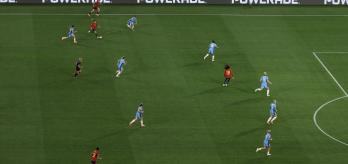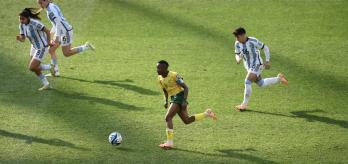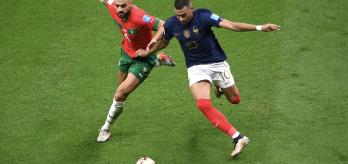Key points
-
The tempo of match play increased substantially in the semi-finals and final of the FIFA Women’s World Cup 2023™. This suggests that the demands intensify as teams approach the business end of the tournament.
-
There was a positive correlation between sprint distance covered by a team in possession of the ball and average points attained per game.
-
High-intensity runs are related to phases of play that have a direct sense of urgency attached to their outcome (e.g. defensive transition and final-third phases).
-
Teams that have an extremely high or low physical output in a match may directly impact their opposition’s demands.
A multitude of factors impact team physical performances
A myriad of factors can up- or downregulate the match physical demands experienced by female players. Indeed, given the multifaceted nature of the game, technical, tactical, social and psychological elements amalgamate during a match.1 Thus, it would be extremely naïve not to acknowledge some of these factors, as they can profoundly alter teams’ physical outputs. Although these factors are countless, some of the most influential aspects include the competition stage, game state, style of play and the standard of both teams involved in a match.2 Information on such factors may be valuable to practitioners and enable them to fully grasp the sheer complexity surrounding these contextual and tactical variables – for instance, how these factors work in isolation and also their interplay and accumulation over the course of various matches. Consequently, this section delves into how physical demands varied according to shifting contexts and tactics during the FIFA Women’s World Cup 2023™.
Contextual influences
Team physical demands across tournament stages
When teams transition from the group stage to the knockout rounds of a major tournament, more significance is naturally placed on winning.3 Previous research has found that this added incentive to win in the knockout stage increases the intensity of match play. For instance, at the FIFA Women’s World Cup™ in Canada in 2015 and in France in 2019, the amount of sprinting (>23.0km/h) increased by 8-12% in the knockout rounds compared to the group stage.4 This trend continued at the FIFA Women’s World Cup 2023, particularly in the semi-finals and final, where the distances covered at higher intensities (>19.0km/h) were substantially greater than in the group stage and the earlier knockout rounds. The total distance covered was relatively stable across the various tournament stages (Figure 1), but markedly more high-intensity running and sprinting occurred as teams approached the latter stages of the tournament (Figures 2 and 3). Moreover, both England and Spain recorded their highest sprinting outputs of the whole tournament in the final. Interestingly, the two finalists at the FIFA World Cup Qatar 2022™, Argentina and France, also produced their greatest sprint distances in the competition’s most important game.5 This suggests that the intensity of match play could be at its greatest at the business end of a tournament.
Team quadrants: relationship between physicality and average points per game
The previous section highlighted that teams physically prime themselves for the latter stages of a tournament. However, do teams that have a higher physical output also obtain more points per game? To gauge this, results in all games at the FIFA Women’s World Cup Australia & New Zealand 2023™ were assigned a points value: three points for a win, one point for a draw and zero points for a loss. Figures 4-7 demonstrate the associations between physical metrics and the average points per game. Relatively weak correlations were found between the average points per game and overall distance covered (r=0.24), high-intensity running (r=0.25) and sprint distance (r=0.31). On the other hand, a moderate association was identified between sprint distance covered by a team in possession of the ball and average points per game (r=0.49). Ten out of the 16 teams that reached the knockout stage were found in the upper-right quadrant (Figure 7), featuring the teams that sprinted the most in possession and also picked up the most points per game. This trend was also found at the FIFA World Cup Qatar 2022, where teams that covered more sprint distance in possession won more games.5
Limitations of this approach
Although it is tempting to attribute this finding heavily to physical characteristics, the reader should be cognisant of the complexities surrounding game outcomes. For instance, some games were won during penalty shoot-outs, which obviously required no sprinting in possession of the ball. This section also used a crude method of allocating points, with three points being assigned for a win despite knockout games being part of an elimination process and therefore their importance not being comparable to that of group games.
Moreover, any inference from a moderate correlation must be treated with caution as it indicates that there is plenty of unexplained variance. Nevertheless, on balance, one should still acknowledge the similarities across the most recent women’s and men’s FIFA World Cup™ tournaments for the in-possession sprinting metric. Thus, in-possession sprinting could be more significant than other physical metrics, but technical and/or tactical metrics remain much more effective in discriminating between successful and unsuccessful teams.
Tactical influences
Links between high-intensity runs and phases of play
There was an expectation that utilising FIFA’s Enhanced Football Intelligence metrics would shed some light on the tactical factors that up- or downregulated the teams’ physical exertions during FIFA Women’s World Cup 2023 games. Thus, to further contextualise the trends from the tournament, physical and tactical metrics were correlated against each other to determine any noteworthy associations. Specifically, this was carried out using the phase-of-play metrics that captured the tactical approach of teams during games. Interestingly, strong associations between the number of high-intensity runs that a team completed and the various phases of play occurred for game situations that had a real sense of urgency attached to their outcome (e.g. a risk of conceding/chance of scoring).
Team quadrants: in-possession and out-of-possession trends
High-intensity out-of-possession efforts included activities to defensively recover and/or transition (Figure 8; r=0.48). The latter two phases were combined given their similar purpose (e.g. to quickly recover into a better shape). Due to the potential consequences of not tracking back, it is not surprising that teams work intensely out of possession during defensive recoveries and/or transitions.6-10 Debutantes the Philippines, Zambia and Panama clearly resided within the upper-right quadrant, performing a plentiful number of each type of action. This could suggest that some of the least experienced teams found it difficult to cope tactically against more seasoned opponents and thus had to recover intensely more often.
Similarly, in-possession high-intensity efforts included movements to progress quickly up the pitch and carry an attacking threat into the final third (Figures 9 and 10; r=0.86-0.88). Both of these associations are remarkably similar and could suggest that teams up their intensity once they progress the ball forward, including into the final third, via vertical passes or dribbles in an attempt to pose an attacking threat.7,10
The more attacking teams in the upper-right quadrant, such as Brazil, Spain and the USA, progressed up the pitch and into the final third quicker and more frequently than deeper, more defensive teams in the lower-left quadrant, such as Costa Rica, the Philippines and Vietnam (Figures 9 and 10). Research has revealed that the greatest proportion of a team’s high-intensity actions occur during fast transition-based activities.8 Thus, the correlations above could indicate that players produce intense running either to recover defensively into a better position or to get forward as part of an attack. However, the reader should view these associations with some caution as correlation does not equal causation.
The opposition’s impact on physical match outputs
A powerful factor modulating a team’s physical outputs is the opposition that they face. This is especially evident when the opposition perform at an extremely high or low intensity. This, among many other factors, may require a team to up- or downregulate their exertions accordingly.3 Figures 11 and 12 show teams with high or low physicality and the impact that this may have had on the work rates of their opposition. Teams at the extremes of the high-intensity continuum (>19.0km/h) included Spain and Zambia at the high end with Costa Rica and Jamaica at the low end. When teams played against Zambia or Spain, they completed 8-21% more high-intensity running and 17-34% more sprint distance compared to in their other games. Costa Rica, Japan and Spain all clearly covered more high-intensity running and sprinting against Zambia than in their remaining matches.
Similarly, playing against Spain resulted in most teams upregulating their high-intensity and sprinting outputs, but Japan were an outlier. By contrast, when playing against Costa Rica or Jamaica, teams covered 5-10% less high-intensity running and 8-10% less sprint distance than in their other games. For instance, Zambia and Japan downregulated their high-intensity and sprint distances against Costa Rica, with Spain the only team to increase their intensity against Las Ticas. The same trend was observed for Jamaica, whose opponents all produced less high-intensity running against the Reggae Girlz than in their other tournament matches.
FIFA’s Enhanced Football Intelligence metrics provide much-needed context
Data obtained from FIFA’s Enhanced Football Intelligence metrics provides valuable context regarding the reason(s) why certain teams impacted their opposition’s physicality. Although Zambia and Spain were two of the most physically intense teams at the tournament, their work-rate profiles were governed by completely opposing tactics. Spain were one of the teams to cover the most high-intensity distance in possession of the ball, while it was the opposite story for Zambia, whose high-intensity distance out of possession was among the tournament’s largest. Thus, both upregulated their opposition’s work rate but in very different ways.
For instance, Spain’s dominance on the ball led to them recording the highest number of movements to receive and the second-greatest number of progression and final-third phase events at the FIFA Women’s World Cup 2023. Once La Roja advanced at speed, they made excellent use of the wide areas to get crosses in and regularly sought to penetrate through runs in behind the opposition’s defensive line, ranking first on both scores. Logically, these activities may not only be physically taxing for Spain’s players but seem to have influenced the work rate of their opponents, who reacted to nullify Spain’s high-intensity in-possession activity. Although Spain averaged the highest ball possession at the tournament, they still occasionally lost the ball and would intensely press, defensively transition and/or recover when tactically required.
Conversely, Zambia’s lack of ball possession resulted in one of the tournament’s lowest tallies of movements to receive. However, Zambia were one of the most intense pressing teams at the competition. This ultimately led to plenty of forced turnovers and enabled the Copper Queens to repeatedly counter-attack at speed. Moreover, Zambia were in the upper percentiles for the total number of counter-presses and defensive transitions, which typically occurred as they lost the ball during attacking incursions. Thus, opponents upregulated their intensity as they passed through Zambia’s press into more attacking areas. The intensity of Zambia’s press also required the opposition to move into space more actively to receive the ball during such scenarios. As Barbra Banda and Co regularly counter-attacked, this also compelled their opponents to summon up a higher work rate in order to defensively transition and/or recover quickly and nullify these rapid attacks.
By contrast, Costa Rica and Jamaica were teams that downregulated the high-intensity work rates of their opponents. Costa Rica produced the least in-possession distance at high intensity at the tournament. They frequently sat compactly in a defensive low block for extended periods. This reduced their own opportunities to move into space and more importantly limited the scope for the opposition to perform high-intensity movements – especially in behind. Costa Rica’s deeper position was evidenced by a high count for recovery-phase efforts but a low number of defensive-transition phase actions. The latter typically occur higher up the field. Their main outlet for offensive activity was through direct play, as attested to by their tournament-high number of long balls. Such direct play is usually easier to nullify than intricate, fast attacks, hence the lower work rate of their opponents.
Similarly, Jamaica recorded one of the lowest values for high-intensity distance in possession of the ball, having performed the fewest movements to receive at the tournament. The Reggae Girlz also frequently sat in a low or mid-block for extended periods, thus limiting the space for the opposition to produce high-intensity actions. Their main attacking outlet was a direct long ball and their number of progressions was among the lowest at the tournament. Given Jamaica’s low numbers of movements to receive, progressions and final-third entries, the opposition racked up fewer reactive movements to defend against them.
The examples presented in this section clearly highlight the influence that varied contexts and tactics have on the physical demands placed on women’s international teams. It is important to mention that there are many other factors that also contribute to varied work rates that have not been covered here.
Although this analysis provides unique insights into the physical demands at the FIFA Women’s World Cup 2023, the reader should be aware of a major limitation. The physical data presented should ideally include acceleration and change of direction metrics to provide a more rounded overview of team and positional demands.
References
-
Bradley PS & Ade JD. Are Current Physical Match Performance Metrics in Elite Soccer Fit for Purpose or is the Adoption of an Integrated Approach Needed? International Journal of Sports Physiology and Performance. 2018, 13(5): 656-664.
-
Paul DJ, Bradley PS & Nassis GP. Factors Affecting Match Running Performance of Elite Soccer Players: Shedding Some Light on the Complexity. International Journal of Sports Physiology and Performance. 2015, 10(4): 516-519.
-
Bradley PS & Noakes TD. Match running performance fluctuations in elite soccer: indicative of fatigue, pacing or situational influences? Journal of Sports Sciences. 2013, 31(15): 1627-1638.
-
FIFA, Physical Analysis of the FIFA Women’s World Cup France 2019™, 2020. Available at: img.fifa.com/image/upload/zijqly4oednqa5gffgaz.pdf. Accessed January 2024.
-
FIFA, A contextualised physical analysis of the FIFA World Cup Qatar 2022™: quantifying the “what”, “when”, “how” and “why”, 2023. Available at: www.fifatrainingcentre.com/en/fwc2022/physical-analysis/background-and-method.php. Accessed January 2024.
-
Bradley PS. ‘Setting the Benchmark’ Part 2: Contextualising the Physical Demands of Teams in the FIFA World Cup Qatar 2022. Biology of Sport. 2024, 41(1): 271-278.
-
Bortnik L, Burger J & Rhodes D. The mean and peak physical demands during transitional play and high pressure activities in elite football. Biology of Sport. 2022, 39(4): 1055-1064.
-
Ju W, Hawkins R, Doran D, Gómez-Díaz A, Martín-García A, Evans M, Laws A & Bradley PS. Tier-specific contextualised high-intensity running profiles in the English Premier League: more on-ball movement at the top. Biology of Sport. 2023, 40(2): 561-573.
-
Bradley P, Ju W, Ade JD, Laws A, Gómez-Díaz A & Evans M. Beyond ‘blind’ distance covered in football match analysis: is it time to progress to a contextualised paradigm? In Football Analytics 2021: The role of context in transferring analytics to the pitch. 2020: 130-145.
-
Ju W, Doran D, Hawkins R, Gómez-Díaz A, Martin-Garcia A, Ade JD, Laws A, Evans M & Bradley PS. Contextualised peak periods of play in English Premier League matches. Biology of Sport. 2022, 39(4): 973-983.
Acknowledgements
A huge thank you to those that supported this research, including FIFA’s Content Managers, Data Scientists, Analysts, Editing Team and many more.













